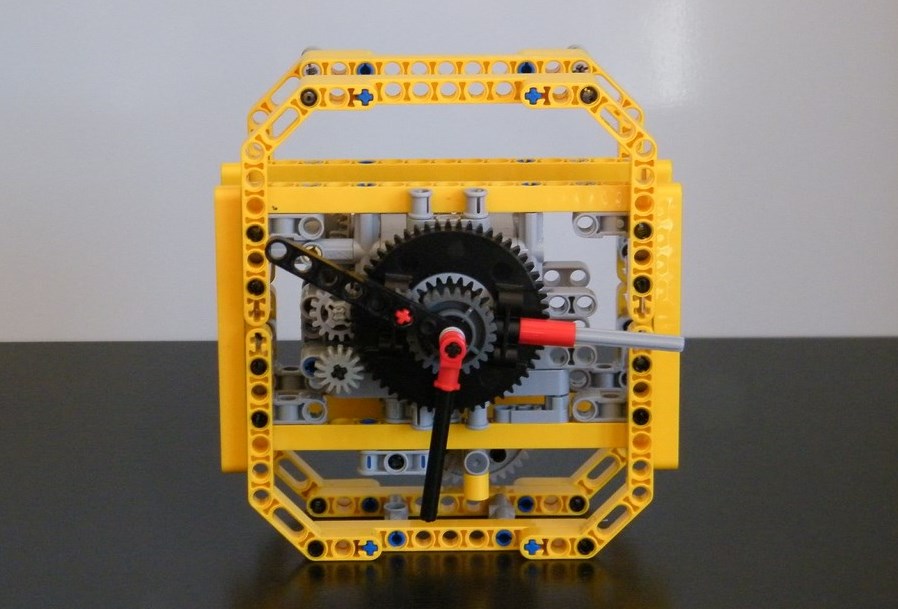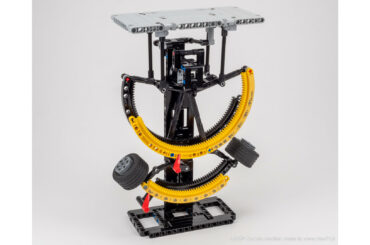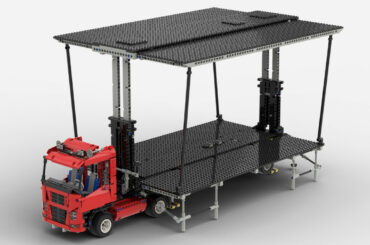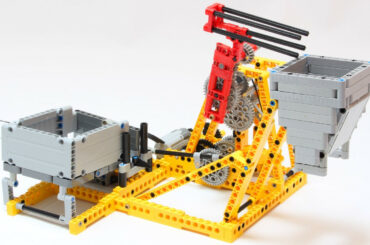A retrospection of my Lego work, including new works and some clock future projects.
Clocks have been one of the biggest field of my research in lego, but as you can see on my blog, they are not the most documented, that is why I wanted to write about several clocks I built including, tests, research, working clocks and non-working clocks.
The beginning : Simple 3-hands clock
The first clock I built was a 3-hands clock with a simple escapement system. Regarding the hands, many clocks have two hands (seconds and minutes or minutes and hours) or three but two on the same axle and one detached in the bottom. Therefore I wanted to build a clock with the 3 hands on the same axle. For that purpose, I have used a Turntable for the hours-hand, a differential for the minutes-hand and the axle for the seconds-axle.
Regarding the gearing, there are the most simple :
- Seconds : 1:1
- Minute : 1:60 = 2 * 2 * 3 * 5 = 8/16t + 8/16 t + 8/24t and 8/40t
- Hours : 1:12 = 3 * 4 = 8/24t +8/16t and 8/16t
The energy is a weight with a winch. The escapement system is copied on the BenVanDerWall escapment with double 40t. This escapement was simple ans reliable. And to finish the performance was modest. With a weight of 300gr with multiplication of 20/12 and 40/8 before the seconds hand, the pendulum was 1 meter tall and the autonomy with 1 meter of string was 15 minutes. That is not very good but is it explained by the system of escapement which is not really energy saver, the axle of rotation is mounted on simple axle which makes frictions with the weight of pendulum. The system of escapement has only 4 notches, which makes the axle one revolution each 4 seconds, the autonomy will be increased if I would have have a 12 notch gear like the big clocks which have hundred of notches gears. Nevertheless the system is very reliable.
If the performance could be measured by the amount of meter of string per minutes, (the more the clock works for a long time with a small amount of weigh drop) per weight unit (big weigh equal bit multiplication in the clock so good autonomy but small weight is better for friction so for the same autonomy, the lighter weight is better). The performances of this clock can be writen :
PerfFactor = Lenght of string / autonomy * weight = 100cm / 15minutes * 300gr = 2000 cm/min*gr
(The smaller the Performance factor is, the better is)
The second clock : improved version of the first
The average performances of my first clock encouraged me to build an other clock which will be more efficient regarding escapement system and autonomy.
The system of internal gearing was the same. I have condensed the mechanism vertically and connected on the back the escapement system. The escapement system was new. I have been inspired by anchor escapment which is an escapement pretty reliable and energy saver. I have made a 12 tooth-gear which enables me to have more autonomy because there are more notches on a revolution of the gear. The weight was 400gr with a multiplication of 5*5 (40/8t and 40/8t) equal 25 (9 on my previous model). With the same length of string and length of pendulum, the autonomy was radically increased : 45min.
PerfFactor = Lenght of string / autonomy * weigh = 100cm / 45minutes * 400gr = 890 cm/min*gr
I have not made a video of this model.
Even if the autonomy was rather good, it has not reached yet the hours or 12 utopian hours. It is due to two things : the first is linked to the pendulum which is attached on the chassis : with a simple axle. This axle causes lot of friction because the weight of the pendulum stresses the axle and makes friction on bearings. The second is a lack of rigidity of the chassis, combined with a big weight causes stresses on bearings, which reduces the efficiency.
The third clock : Cuckoo Clock
On may 2010, Setechnic (now called Techlug) launch a new contest : creating a clock with working cuckoo ! As a fan of clock, I took up the challenge. The first idea I have, before building the cuckoo mechanism was to used the weight of clock to powered itself, like on this clock. I wanted to mix this idea with a house design, that is why I created a pylon with rack pinion on it, sliders system and gearings. And of course the pylon passed through the fireplace
Nevertheless, it didn’t work well. The weight of the house was not balanced and the pendulum made vibrations and oscillations which interfered with the functioning. That is why I have chosen to change the system of pendulum for a horizontal oscillation pendulum. You can see the result here. It worked good, the autonomy was 1 hour with 1 meter of string and 300 gr of weight which gives a performance factor of :
Perf = Lenght of string / autonomy * weigh = 100cm / 60 minutes * 300gr = 500 cm/min*gr
To compare with the first version, this version of clock mechanism is 4 time more efficient. But the axle of rotation of pendulum is still mounted on simple axle which causes frictions. That is why it is always possible to make better.
To conclude this first part. I was always fascinated by clocks and time mechanisms. It is a widespread theme which brings lot of idea and cleverness. For the second part, I will talk about the last attempst to create a clock on 2013 year.








(2) Comments
There are instructions for the cuckoo clock.
where are the instructions
Comments are closed.